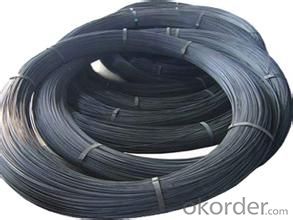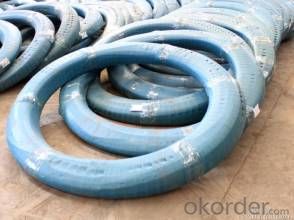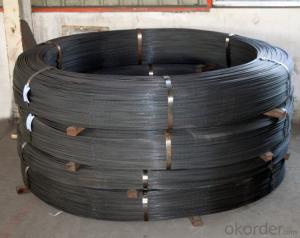Alloy Strand Steel Wires
- Loading Port:
- China Main Port
- Payment Terms:
- TT or LC
- Min Order Qty:
- -
- Supply Capability:
- -
OKorder Service Pledge
OKorder Financial Service
You Might Also Like
Quick Details
| Steel Grade: | SWRH77B, SWRH82B | Standard: | ASTM,BS,GB,JIS | Wire Gauge: | 4.0mm-10.0mm |
| Place of Origin: | Tianjin China (Mainland) | Type: | Drawn Wire,Spiral/Helical Ribs, Round Plain | Application: | Construction |
| Alloy Or Not: | Is Alloy | Special Use: | Free Cutting Steel | Model Number: | 4.0-10.0mm |
| Product Name: | prestressed steel wire 4mm high carbon steel wire | Size: | 4.0-10.0mm | ||
| Strength: | 1570/1670/1770/1860 N/mm2 | Relaxation: | Less than 2% (1000hour) | Elongation: | Not less than 4% |
| MOQ: | 10 Tons | Payment: | TT, LC | Delivery: | 10-15 work days |
| Package: | As your requirements |
Packaging & Delivery
| Packaging Detail:steel strand coil to be packed in damp proof materials strapped with 8 bands on one wooded pallet with an outer layer of plastic used for anti-rainshower 2 or 3 wooden block undermeath each coil. | |
| Delivery Detail:within 2 weeks |
Specifications
high carbon class A steel wire
Constructon:7 steel wire
material:wire 82B
FAQ of Alloy Strand Steel Wires
①How is the quality of your products?
Our products are manufactured strictly according to national and internaional standard, and we take a test
on each product before delivered out. If you want see our quality certifications and all kinds of testing report, please just ask us for it.
Guaranteed: If products’ quality don’t accord to discription as we give or the promise before you place order, we promise 100% refund.
②How about price?
Yes, we are factory and be able to give you lowest price below market one, and we have a policy that “ for saving time and absolutely honest business attitude, we quote as lowest as possible for any customer, and discount can be given according to quantity”,if you like bargain and factory price is not low enough as you think, just don’t waste your time.Please trust the quotation we would give you, it is professional one.
③Why should you chose us?
Chose happens because of quality, then price, We can give you both.Additionally, we can also offer professional products inquiry, products knowledge train(for agents), smooth goods delivery, exellent customer solution proposals.Our service formula: good quality+good price+good service=customer’s trust
SGS test is available, customer inspection before shipping is welcome, third party inspection is no problem.
Alloy Strand Steel Wires Images


Any question, pls feel free to contact us !
- Q:How is steel wire rod used in the production of wire for suspension bridge cables?
- Steel wire rod is a crucial component used in the production of wire for suspension bridge cables. The wire rod is made from high-quality steel and is typically produced through a process called hot rolling. To create wire for suspension bridge cables, the steel wire rod undergoes several stages of processing. Firstly, the wire rod is heated and then passed through a series of rollers, which gradually reduce its size and shape it into a long, continuous wire. This process is known as wire drawing. The resulting wire is then further processed to enhance its strength and durability. It undergoes a heat treatment process, such as annealing, to improve its mechanical properties. This treatment helps increase the wire's tensile strength, ensuring it can withstand the immense loads and stresses experienced by suspension bridge cables. Once the wire has been appropriately treated, it is then carefully woven and braided to create the final suspension bridge cable. Multiple wires are twisted together to form strands, and several strands are then twisted together to create a larger cable. This intricate weaving process ensures that the cable is strong, flexible, and resistant to corrosion. The use of steel wire rod in the production of suspension bridge cables is crucial due to its exceptional strength-to-weight ratio. Steel is renowned for its high tensile strength, making it an ideal material for supporting heavy loads over long spans. Additionally, steel wire rod offers excellent resistance to corrosion, ensuring the longevity and structural integrity of suspension bridge cables. Overall, steel wire rod plays a vital role in the production of wire for suspension bridge cables, providing the necessary strength, durability, and flexibility required for these critical infrastructure components. Its versatility and reliability make it a preferred material choice in the construction of suspension bridge cables, ensuring the safety and functionality of these impressive engineering marvels.
- Q:How is steel wire rod used in the manufacturing of cable wires?
- Steel wire rod is used in the manufacturing of cable wires as it serves as the raw material for producing the high-strength, durable and reliable core of the cable. The wire rod is first drawn through a series of dies to reduce its diameter and increase its length. This process, known as wire drawing, helps in achieving the desired thickness and quality of the cable wire. Additionally, steel wire rod provides the necessary tensile strength and flexibility required for the cable wire to withstand the stresses and strains of various applications, such as electrical wiring, telecommunications, and construction.
- Q:How does the corrosion resistance of steel wire rod vary with different wire drawing processes?
- The corrosion resistance of steel wire rod can vary depending on the specific wire drawing processes used. Wire drawing processes involve pulling the steel wire rod through a series of dies to decrease its diameter and increase its length. One important factor that affects the corrosion resistance is the surface finish of the wire after the drawing process. Wire drawing processes can result in different surface finishes, such as bright, galvanized, or coated. These surface finishes can provide additional protection against corrosion by acting as a barrier between the steel wire rod and the corrosive environment. Another factor that influences corrosion resistance is the reduction in diameter during the wire drawing process. As the diameter decreases, the surface area of the wire increases, which can lead to increased corrosion susceptibility. However, this can be mitigated by selecting appropriate wire drawing processes that provide a consistent and uniform reduction in diameter, as well as by utilizing corrosion-resistant coatings or treatments. Additionally, the choice of wire drawing lubricants and cooling methods can impact the corrosion resistance of the steel wire rod. Proper lubrication during the drawing process reduces friction between the wire and the dies, minimizing surface defects and potential corrosion sites. Effective cooling methods can prevent overheating of the wire during drawing, which can also affect its corrosion resistance. In summary, the corrosion resistance of steel wire rod can be influenced by various factors related to the wire drawing process. These include the surface finish, reduction in diameter, lubrication, and cooling methods employed. By carefully selecting and optimizing these factors, manufacturers can enhance the corrosion resistance of steel wire rod, ensuring its long-term durability and performance in corrosive environments.
- Q:How is steel wire rod used in the production of wire brushes?
- Steel wire rod is used as the main raw material in the production of wire brushes. It is drawn through a series of dies to form the bristles of the brush. The rod is typically made of high-quality steel, ensuring durability and strength in the bristles. These bristles are then attached to a handle or base, creating a functional wire brush that can be used for various applications such as cleaning, polishing, or removing rust and debris.
- Q:What are the different transportation methods for steel wire rod?
- Different transportation methods are available for steel wire rod, depending on the distance and logistics involved. Some common options include: 1. Trucking: Trucks are a versatile and popular choice for transporting steel wire rod. They can carry large quantities and reach various locations, including remote areas. Trucking is suitable for both domestic and international shipments, particularly for shorter distances. 2. Rail transport: Rail transport is efficient for long-distance transportation of steel wire rod. It has a higher capacity and can handle heavy loads. This method is commonly used to ship steel wire rod from manufacturing plants to distribution centers or ports, providing cost-effective and reliable transportation. 3. Ocean freight: International transportation of steel wire rod can be done through ocean freight. This involves loading the cargo onto cargo ships in containers or as bulk cargo. Ocean freight is suitable for long distances, especially for exporting or importing steel wire rod to different countries. 4. Air freight: Although costly, air freight is an option for fast delivery of steel wire rod. Airplanes can carry smaller quantities and are often used for urgent or time-sensitive shipments. This method is particularly beneficial for international trade or when transporting to remote areas with limited road or rail access. 5. Barge transport: Barge transport is effective for areas with accessible waterways. Barges are flat-bottomed boats designed for heavy cargo, including steel wire rod. This mode of transportation is commonly used for inland waterways like rivers and canals, offering cost-effective and environmentally friendly options. When selecting the appropriate transportation method for steel wire rod, it is important to consider factors such as cost, distance, delivery time, and logistics requirements. Each method has its advantages and limitations, and the choice depends on the specific needs and circumstances of the shipment.
- Q:What are the different types of steel wire rod rolling mills?
- There are several types of steel wire rod rolling mills, including continuous mills, semi-continuous mills, and reversing mills. Continuous mills are designed for high-speed production and feature a constant flow of material through the mill. Semi-continuous mills allow for a slower production rate and are ideal for smaller-scale operations. Reversing mills have the ability to roll the material in both directions, providing flexibility for different product specifications.
- Q:How is steel wire rod used in the production of wire strands for suspension bridges?
- Wire strands for suspension bridges rely heavily on steel wire rod as a fundamental component. The wire rod acts as the primary material from which the wire strands are fabricated. To create wire strands for suspension bridges, a series of procedures are applied to the steel wire rod. Firstly, the wire rod undergoes a thorough cleansing and inspection to verify its compliance with the specified requirements. Subsequently, the wire rod is passed through a sequence of rollers in order to decrease its diameter and increase its length. This procedure, known as cold drawing, enhances the wire's strength and flexibility. Once the wire rod has been drawn, it usually receives a protective coating to prevent corrosion. The type of coating applied may vary depending on the specific demands of the bridge and the environmental conditions in which it will be installed. Common coating options include zinc, epoxy, and galvanized coatings. After the wire rod has been coated, it is then transformed into wire strands. This is achieved by intertwining multiple wires together to form a single strand. The number of wires twisted together can vary based on the design and load requirements of the suspension bridge. The twisting process is meticulously controlled to ensure that the wire strands possess the necessary strength and durability to withstand the tension and stress they will encounter during use. Once the wire strands have been created, they are typically subjected to testing to confirm that they meet the required strength and quality standards. This may involve conducting various tests such as tensile strength tests, corrosion resistance tests, and fatigue tests. Only wire strands that successfully pass these tests are deemed suitable for use in suspension bridges. Finally, the wire strands are assembled and installed in the structure of the suspension bridge, providing vital support and load-bearing capacity. These wire strands are typically anchored at both ends of the bridge and connected to the bridge deck and towers, resulting in a sturdy and durable structure capable of carrying heavy loads over long distances. In conclusion, steel wire rod plays a critical role in the production of wire strands for suspension bridges. Through processing, coating, and formation, wire strands with the necessary strength and flexibility are created to support the bridge structure. The meticulous manufacturing and testing processes ensure that the wire strands meet the necessary safety and reliability standards for use in suspension bridges.
- Q:How is steel wire rod packaged for transportation and storage?
- Steel wire rod is typically packaged for transportation and storage in coils or bundles. The wire rod is wound into large coils, which are then secured with steel straps or wires. Alternatively, smaller bundles may be created by grouping several rods together and wrapping them with plastic or steel straps. This packaging ensures ease of handling, prevents damage during transit, and allows for efficient storage in warehouses or yards.
- Q:How are steel wire rods used in the manufacturing of welding wires?
- Steel wire rods are commonly used as the primary raw material in the manufacturing of welding wires. These rods are typically drawn through a series of dies to achieve the desired diameter and shape for the welding wire. The steel wire rods provide strength, durability, and conductivity to the final welding wire, ensuring reliable performance during welding processes.
- Q:How is steel wire rod coated for corrosion protection?
- Steel wire rod is coated for corrosion protection through a process called galvanization. This involves immersing the wire rod in a bath of molten zinc, which forms a protective layer over the surface of the steel. The zinc coating acts as a barrier, preventing contact between the steel and corrosive elements, thereby significantly reducing the risk of corrosion.
1. Manufacturer Overview |
|
|---|---|
| Location | |
| Year Established | |
| Annual Output Value | |
| Main Markets | |
| Company Certifications | |
2. Manufacturer Certificates |
|
|---|---|
| a) Certification Name | |
| Range | |
| Reference | |
| Validity Period | |
3. Manufacturer Capability |
|
|---|---|
| a)Trade Capacity | |
| Nearest Port | |
| Export Percentage | |
| No.of Employees in Trade Department | |
| Language Spoken: | |
| b)Factory Information | |
| Factory Size: | |
| No. of Production Lines | |
| Contract Manufacturing | |
| Product Price Range | |
Send your message to us
Alloy Strand Steel Wires
- Loading Port:
- China Main Port
- Payment Terms:
- TT or LC
- Min Order Qty:
- -
- Supply Capability:
- -
OKorder Service Pledge
OKorder Financial Service
Similar products
New products
Hot products
Related keywords


























